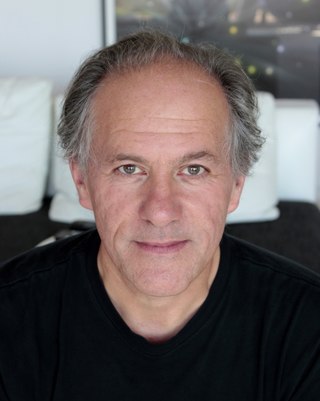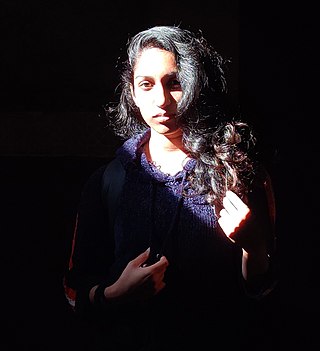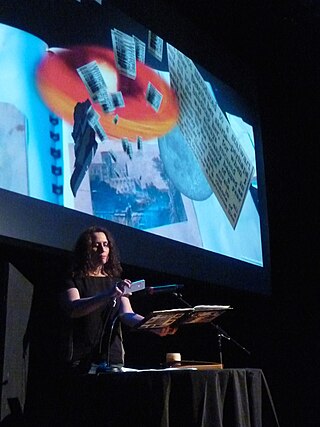
Emily Carr was a Canadian artist who was inspired by the monumental art and villages of the First Nations and the landscapes of British Columbia. She also was a vivid writer and chronicler of life in her surroundings, praised for her "complete candour" and "strong prose". Klee Wyck, her first book, published in 1941, won the Governor General's Literary Award for non-fiction and this book and others written by her or compiled from her writings later are still much in demand today.

The Emily Carr University of Art + Design is a public university of art and design located in Vancouver, British Columbia, Canada. The institution is named for Canadian artist and writer Emily Carr, who was known for her Modernist and Post-Impressionist artworks.
Fiona Bowie is a Vancouver-based Canadian installation artist. She uses film, video, photography and sculpture, and makes "immersive environments".
Microwave International New Media Arts Festival is a new media art festival based in Hong Kong. It began in 1996 as the annual video art festival for local video art collective Videotage.

George Legrady is a multidisciplinary digital media artist and university professor in photography and computational media arts.
The Cultural Olympiad Digital Edition (CODE) was a digital art showcase at the 2010 Winter Olympics in Vancouver, Canada. The festival, which lasted from February 4 to 21, was the first of its kind at a major sporting event, showcasing the new digital media styles in art, music, and film.
Sheelagh Carpendale is a Canadian artist and computer scientist working in the field of information visualization and human-computer interaction.
Julie Andreyev is a Vancouver-based multidisciplinary artist whose practice explores themes of animal agency and consciousness. Her ongoing Animal Lover work explores nonhuman animal agency and creativity through modes of interspecies collaboration and aleatoric methods. The Animal Lover projects seek to contribute towards an ethic of compassion and regard for the intrinsic worth of other-than-human individuals. She was born in Burnaby, British Columbia.
Lorna Brown is a Canadian artist, curator and writer. Her work focuses on public space, social phenomena such as boredom, and institutional structures and systems.
Deanna Bowen is an interdisciplinary artist whose practice includes films, video installations, performances, drawing, sculpture and photography. Her work addresses issues of trauma and memory through an investigation of personal and official histories related to slavery, migration, civil rights, and white supremacy in Canada and the United States. Bowen is a dual citizen of the US and Canada. She lives and works in Montreal.
Annie Briard is a Canadian intermedia visual artist based in Vancouver, British Columbia. Her video, photographic, and installation-based work explores the intersections of perceptual paradigms between psychology, neuroscience and existentialism, challenges the uncertain nature of perception itself, and memory.
Alexandra Bischoff is a Canadian artist who works primarily in performance, with an emphasis on sexuality and feminism. She lives and works in Montréal, Quebec.
Vanessa Kwan is an art curator and artist based in Vancouver, British Columbia, Canada who believes in collaborative, site-specific and cross-disciplinary practices.
Cecily Nicholson is a Canadian poet, arts administrator, independent curator, and activist. Originally from Ontario, she is now based in British Columbia. As a writer and a poet, Nicholson has published collections of poetry, contributed to collected literary works, presented public lectures and readings, and collaborated with numerous community organizations. As an arts administrator, she has worked at the Surrey Art Gallery in Surrey, British Columbia, and the artist-run centre Gallery Gachet in Vancouver.

Giovanni Aloi is an author and curator specializing in the representation of nature in modern and contemporary art. He teaches art history and visual culture at School of the Art Institute of Chicago. He is the Founder and Editor in Chief of Antennae: The Journal of Nature in Visual Culture and is the co-editor of the University of Minnesota Press book series Art after Nature. Aloi is also USA correspondent for Esse Magazine Art+Opinion.

Daina Warren is a Canadian contemporary artist and curator. She is a member of the Montana Akamihk Cree Nation in Maskwacis, Alberta. Her interest in curating Aboriginal art and work with Indigenous artists is at the forefront of her research.
Tsēma Igharas, formerly known as Tamara Skubovius, is an interdisciplinary artist and member of the Tāłtān First Nation based in Vancouver, British Columbia. Igharas uses Potlatch methodology in making art, to assert the relationships between bodies and the world, and to challenge colonial systems of value and measurement of land and resources.

Emelina Soares is an Indian artist, art historian, and educator who uses site-specific installation, animation, projection, drawing, printmaking, and sculpture. Common themes of her works include ecology, ethology, migration, and cultural exchanges.
Doris Shadbolt, née Meisel LL. D. D.F.A. was an art historian, author, curator, cultural bureaucrat, educator and philanthropist who had an important impact on the development of Canadian art and culture.

Caitlin Fisher is a Canadian media artist, poet, writer, futurist and Professor of Cinema and Media Arts at York University in Toronto where she also directs the Immersive Storytelling Lab and the Augmented Reality Lab. Fisher is also a Co-founder of York’s Future Cinema Lab, former Fulbright and Canada Research Chair, and an international award-winning digital storyteller. Creator of some of the world’s first AR poetry and long-from VR narratives. Pioneer of research-creation who defended Canada's first born-digital dissertation. Member of the early AR artist collective Manifest AR. Fisher is also known for the 2001 hypermedia novel These Waves of Girls, and for her work creating content and software for augmented reality. "Her work is poetic and exploratory, currently combining the development of authoring software with evocative literary constructs."






